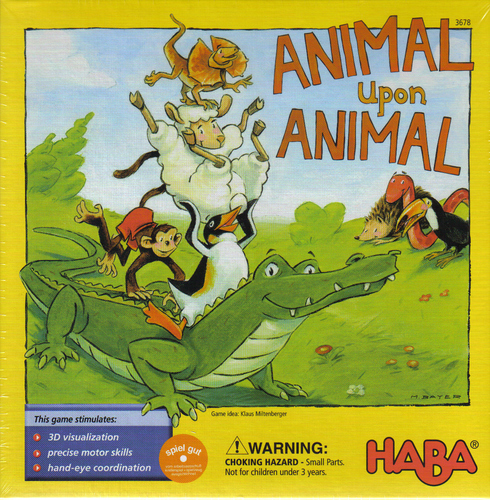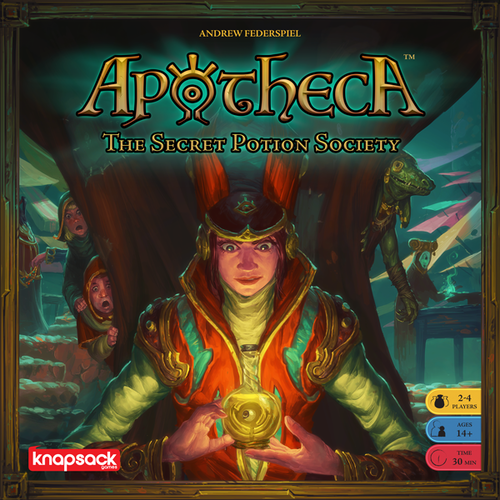Memoir ’44 Operation Overlord
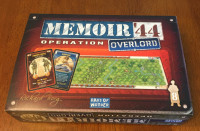
Yesterday, June 6, was the commemoration of D-Day – the day Allied forces stormed the beaches of Normandy to turn the tide in WWII.
In my own small way, I like to commemorate the event by playing Memoir ’44 – one of my favorite board games. And I’m lucky enough to have a group of friends that now enjoy doing the same every year as well.
So this week, once again we settled in for getting together to play Memoir ’44.
While Memoir ’44 is a two player game, there’s a way for more players to join in the fun. And that’s with Operation Overlord!
Operation Overlord is an expansion to Memoir ’44 that allows up to 8 players to join in a massive WWII battle in a team vs. team approach.
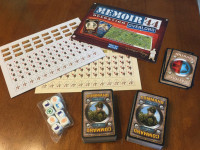
And it’s a lot of fun!
But is it as fun as the normal, 2-player game of Memoir ’44?
Let’s find out.
Memoir ’44 Operation Overlord
The first thing to note is that the Operation Overlord expansion isn’t actually required to play Overlord scenarios. But as we’ve just discovered – it sure helps a ton.
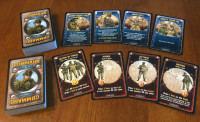
All you really need to play Overlord scenarios are two sets of the Memoir ’44 base game and the downloadable rules and scenarios. Which is the way we played the game last year.
But this year, in preparation for playing this week, I decided to purchase the expansion set. And I’m so glad I did!
The biggest difference, that makes the game more enjoyable with the actual expansion is the deck of command cards. Without the expansion, players combine the command cards from the 2 base games and follow a sort of “translated” list of instructions for the cards.
The downloadable rules include information on how the base game command cards are to be played in the Overlord scenarios. So while choosing the cards to play, you must think through how they differ when playing in Overlord mode.
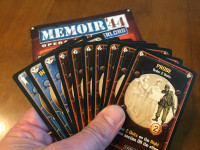
But with the official Operation Overlord command cards, there is not translation/adjustment needed. All the proper information is on the card as well as additional symbols that make playing so much simpler.
The expansion also comes with 8 additional Memoir ’44 dice as well as tokens representing the different armies. So if you don’t have a second base game to use, you can play with the tokens for stand-in figures. But since one of my buddies has a base game, we don’t need to use the tokens.
So the big difference comes down to the command card deck. And for me, buying this expansion for those cards was totally worth it.
How to Play Memoir ’44 Operation Overlord
I won’t go into the basics of playing Memoir ’44 in this section, but rather just the differences of playing with Operation Overlord. For the info on the basics playing Memoir ’44, check out our full review of the board game.
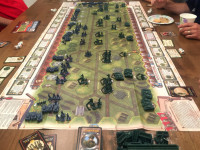
The major difference with Operation Overlord is the ability for up to 8 players to play 4 vs. 4 in a team approach. It isn’t required to have 4 on each side, but it’s set up that way. In our game this week we had 6 players so we battled 3 vs. 3.
The other big difference is the size of the scenario.
Operation Overlord combines 2 game boards side by side for an expansive view of a WWII battle. In addition, Days of Wonder created Battle Maps that can be used for Overlord and that’s what we used this week. Instead of setting out 2 boards and all the terrain tiles that go with it, the battle maps have all the terrain pre-printed on them.
The battle maps also have icons to show the set up of all the starting troops and units. And when you’re talking about that big of a game board area, it makes set up so much easier.
The objective in each Overlord scenario is also much larger.
In a typical Memoir ’44 game, players compete to be the first to 4, 5, or 6 victory medals. But in the Overlord scenarios, players compete for up to 3 times that amount. For example in the scenario we played this week, we were battling for 17 victory medals!
But the size of the board and amount of medals for victory aren’t the only difference in game play.
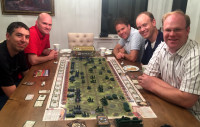
The method and flow of play is all changed up in Operation Overlord as well.
In Operation Overlord, each team is comprised of a Commander-in-Chief and Field Generals.
With 4 players to a team, 1 person is the Commander-in-Chief, 1 the left field general, 1 the center field general, 1 one the right field general. With 3 players to a team, like we played this week, 1 person plays the Commander-in-Chief as well as the center field general while the other 2 players take the left and right field general positions.
While playing, the Commander-in-Chief is the player who holds/controls all the command cards for the team.
On a turn, the Commander-in-Chief selects 1, 2, or 3 cards from his hand to distribute to his field generals or play directly from his hand. And this is where the new Operation Overload deck of cards comes in so handy.
Since the Commander-in-Chief in Overlord scenarios have a hand size of 9 or 10 cards that they are to keep to themselves, using the card holders for the cards doesn’t work. Instead he must hold his cards in-hand.
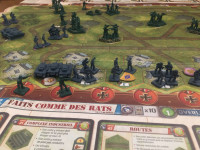
With the official deck of cards, there are symbols at the top of each card that indicate which field general can receive that card. So at a glance, the Commander-in-Chief can figure out what he has to divvy out. So slick!
While the Commander-in-Chief can give out up to 3 cards to his field generals, he will only draw 2 cards at the end of the turn. So he must be judicious of when to do so or he’ll quickly be low on options.
Once a Field General has received a card, he plays that card to order troops in one of the sections he commands. If he doesn’t get a card from the Commander-in-Chief, he can choose to act of his own initiative. But doing so may have a cost.
To act of his own initiative, the field general rolls one battle die. If the result is an Infantry symbol, he can order 1 Infantry unit. If the result is Armor, he can order 1 Armor unit. If the result is a Star, he can order 1 unit of his choice. But if a Flag is rolled, he must select 1 unit to retreat. And if a Grenade symbol is rolled, he must choose one of his units to lose 1 figure. Ouch.
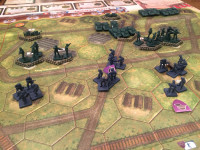
After all field generals have selected their units to be ordered, they follow the same pattern of the base game play: first all ordered units move, then all units who can battle do so.
Since the board is large and all field generals may be ordering units, to keep track we would place a die next to a unit that was ordered and can battle. So the left general would order and move his units and if they would be able to battle, he’d place a die next to them. Then the center general would order and move units and likewise place a die next to those that will battle. And the right general would do the same. Then we could see at a glance all those units for this turn that could battle and we’d start rolling dice.
After the battles, the Commander-in-Chief draws 2 command cards and play switches to the other side.
Once a team achieves the total medal count, they are victorious!
Is Operation Overlord more fun than the base game?
Memoir ’44 Operation Overlord is a lot of fun to play.
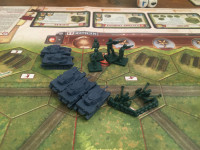
If you’ve got a group of friends that enjoy Memoir ’44, Operation Overlord is definitely a must play. Joining forces to play through a massive scenario makes for a great night.
Playing with a Commander-in-Chief that issues order for Field Generals to carry adds a fun element to the battles.
But also be aware that there’s much more down time during the game.
Of course the game takes longer to play simply because of the number of medals needed to achieve victory. But there’s also less action for each player.
For example, with 8 players, the Commander-in-Chief won’t be rolling any dice. All units ordered and dice rolling is done just by the field generals. And they may or may not operate the affairs in their section of the battle as the Commander-in-Chief had in mind.
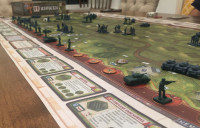
It’s a great interplay of commanders and generals directing the efforts, but for each player, there is more watching than playing.
If I’m the left field general, I may not receive a command card on our team’s turn. So I get to watch my teammates play their cards, order and move their troops, then do their battles. Then it goes to the other side who I also watch carry out their orders and battles.
Or I can choose to act of my own initiative and roll a die on the chance I can order one unit in my command. I’ve got a 66% chance of ordering 1 unit. So I’ll most likely do that. But again, that will be just 1 unit and 1 battle I can roll for after which my teammates may roll for multiple battles and then the other team may roll multiple times before it gets back to me ordering units and rolling.
That being said, we’ve found that even when we aren’t the ones actively ordering and battling, we’ve all been invested and very interested in what’s occurring across the whole battlefield. So while there’s more downtime for each player, the interest in the game has remained high for each player throughout the scenario.
So in the end, which do I like the most?
I prefer the original, base game, 2-player, head-to-head playing of Memoir ’44.
I love the back and forth nature of immediately getting a chance to counteract what my opponent has just done. And we can play through multiple scenarios in the same amount of time that we can play one scenario in Operation Overlord.
Which is great because that’s the way I’m going to play it the most anyway.
Trying to get a group together to play Operation Overlord is tough when all of us have families.
But even though it’s tough to get the gang together for a full operation, it’s still a great experience and a way that we enjoy playing at least once a year. And doing so as a way to commemorate D-Day is an enjoyable experience.

